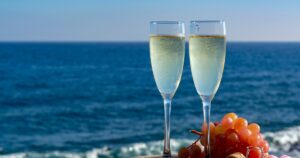The Beginnings: A Humble Start with Great Ambitions
Laurent-Perrier was founded in 1812 by André Michel Pierlot, who recognized the potential of the chalky, sun-drenched soils of the Champagne region. His passion for creating refined sparkling wines laid the foundation for a legacy that would endure for centuries. When Eugénie Laurent, Pierlot’s widow, took over the house after his passing, she lent her name to the brand—thus, Laurent-Perrier was born. Under her leadership, the champagne house grew in reputation and stature, establishing a name synonymous with finesse and quality.
In 1939, Marie-Louise Lanson de Nonancourt took over the struggling business, steering it through turbulent times and setting it on a course for greatness. Her son, Bernard de Nonancourt, would go on to play a pivotal role in shaping Laurent-Perrier into the innovative powerhouse it is today.
Bernard de Nonancourt: The Visionary Behind the Revolution
The name Bernard de Nonancourt is inextricably linked with Laurent-Perrier’s remarkable rise in the 20th century. When he joined the house in 1948, Bernard brought with him not only an unyielding passion for champagne but also a desire to challenge conventions. He introduced new techniques that focused on purity, freshness, and a delicate approach to the winemaking process—a distinct style that would set Laurent-Perrier apart from its competitors.
One of Bernard’s most notable contributions was his emphasis on blending. He believed that the best champagnes were those that reflected balance and harmony, achieved through a meticulous selection of Chardonnay, Pinot Noir, and Pinot Meunier grapes. His innovative approach resulted in Laurent-Perrier’s signature style: a champagne that is consistently light, fresh, and elegant.
A Tradition of Innovation
Laurent-Perrier has consistently pursued a balance between tradition and forward-thinking practices. The house became known for pioneering the production of non-vintage brut champagnes, with Laurent-Perrier Brut L.P. gaining a reputation for its crispness and distinctive finesse. This philosophy of combining heritage with new techniques led to the creation of some of the brand’s most beloved cuvées.
In 1968, Laurent-Perrier introduced Cuvée Rosé, a sparkling rosé champagne that was both audacious and revolutionary. Crafted from 100% Pinot Noir using the maceration method, Cuvée Rosé quickly became iconic for its vibrant color, fresh berry notes, and beautifully balanced structure. It demonstrated Laurent-Perrier’s willingness to innovate while respecting the integrity of the fruit—a daring move that redefined rosé champagnes.
The introduction of Grand Siècle, a prestige cuvée that combines wines from three exceptional vintages, is another testament to the house’s commitment to crafting exceptional champagnes. Named after France’s “Great Century,” Grand Siècle reflects a pursuit of perfection and elegance, embodying the essence of blending to achieve excellence beyond a single harvest.
Commitment to Sustainability
In recent years, Laurent-Perrier has expanded its focus to include sustainable winemaking practices. The house has committed to reducing its carbon footprint, preserving the biodiversity of the Champagne region, and ensuring that its production methods are as environmentally friendly as possible. These initiatives reflect a dedication to the future of winemaking, ensuring that Laurent-Perrier’s unique terroir can be enjoyed by generations to come.
By installing solar panels, optimizing water use, and reducing chemical treatments in their vineyards, Laurent-Perrier exemplifies how innovation is not only about pushing the boundaries of taste but also about nurturing the earth that yields these exceptional wines.
The Present and Future of Laurent-Perrier
Today, Laurent-Perrier remains one of the last family-owned champagne houses, proudly carrying the torch of creativity and quality. Led by the de Nonancourt family, Laurent-Perrier continues to uphold the values instilled by Bernard: excellence, independence, and a commitment to pushing the limits of winemaking. The house’s champagnes, from Brut L.P. to Ultra Brut—the first “zero dosage” champagne introduced in 1981—reflect an unrelenting pursuit of purity.
As Laurent-Perrier looks to the future, it does so with a steadfast commitment to innovation. It is a house that refuses to rest on its laurels, always seeking to find new ways to elevate the champagne experience. Whether it’s refining a vintage or embracing the latest in sustainable practices, Laurent-Perrier embodies a marriage of history, craftsmanship, and creativity.
Conclusion
From its beginnings under André Michel Pierlot to the visionary leadership of Bernard de Nonancourt, Laurent-Perrier’s journey has been one of passion, resilience, and a constant drive to innovate. Today, the house stands as a beacon of the very best in Champagne, combining tradition with a pioneering spirit to craft wines that are celebrated around the world.
With each bottle opened, Laurent-Perrier offers a glimpse into its storied past and its forward-looking philosophy—a blend of tradition, innovation, and an unwavering pursuit of excellence.
𐡸 𐡸 𐡸 𐡸 𐫱 𐡷 𐡷 𐡷 𐡷
Frequently asked questions
Laurent-Perrier’s signature style is characterized by its lightness, freshness, and elegance. The house achieves this through meticulous blending, focusing on balance and harmony using Chardonnay, Pinot Noir, and Pinot Meunier grapes.
Cuvée Rosé is crafted from 100% Pinot Noir using the maceration method, which gives it a vibrant color and fresh berry notes. It was revolutionary at the time of its release and remains one of the most iconic rosé champagnes.
Laurent-Perrier has implemented sustainable practices such as installing solar panels, optimizing water use, and reducing chemical treatments in their vineyards. These efforts are part of their commitment to preserving the environment for future generations.
Bernard de Nonancourt was instrumental in shaping Laurent-Perrier’s success in the 20th century. His passion for innovation and dedication to quality transformed the house into a leading champagne producer.
Yes, Laurent-Perrier remains one of the last family-owned champagne houses. The de Nonancourt family continues to lead the house, upholding the values of excellence, independence, and innovation.



